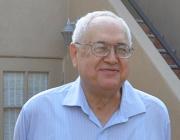Date Published:
NOV 15Abstract:
Ultrafast spin-flip is used to monitor the subpicosecond intersystem crossing dynamics from the (1)Pi to the (3)Pi state following photodissociation of ClF isolated in an Ar matrix by means of pump-probe spectroscopy. After photoexcitation of the (1)Pi state analysis of the populations of triplet states shows that about 50 percent of the spin-flip occurs during the first bond stretch which takes about 250 fs. The early time dynamics of the Cl-F bond in an Ar matrix is investigated theoretically by selecting representative singlet and triplet excited states from a diatomics-in-molecules Hamiltonian. In a one-dimensional model, wave-packet simulations for the first excursion are performed which give a lower limit of about 60 fs for the spin-flip process. The ultrafast spin flip is supported by the caging of the wave packet by the neighboring Ar atoms. Already before collision of the F and Ar atoms the rather large energy gap between the (1)Pi and (3)Pi states in the Franck-Condon region is reduced rapidly to near degeneracy. As a consequence the spin-orbit interaction becomes dominant, inducing more than 40% admixture of the triplet character in the (1)Pi state. Subsequent kinetic energy transfer from ClF to Ar, not yet included in the model, should slow down the Cl and F atoms on their way back toward shorter bond distances, implying stabilization of the wave packet in the (3)Pi state, where it is monitored by the probe laser pulse.Notes:
Annual Meeting of the Deutsche-Bunsen-Gesellschaft-fur-Physikalische-Chemie, POTSDAM, GERMANY, MAY 09-11, 2002
